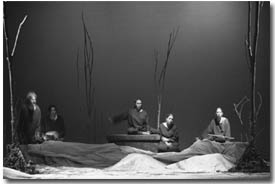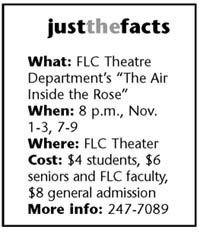|

|

written by Jennifer
Reeder
 It’s not every day that Durangoans have the chance to
“explore exciting possibilities of mask, puppet, dance
and shadow,” so that’s one reason to watch “The
Air Inside the Rose.” The show, brought to us by the Fort
Lewis Theatre Dept., consists of three performance pieces and
opens Friday.
It’s not every day that Durangoans have the chance to
“explore exciting possibilities of mask, puppet, dance
and shadow,” so that’s one reason to watch “The
Air Inside the Rose.” The show, brought to us by the Fort
Lewis Theatre Dept., consists of three performance pieces and
opens Friday.
“(The three pieces) all have different story lines, but
the motif that keeps coming back is that thing we want or desire
but for some reason can’t attain,” says Dr. Kathryn
Moller, who directs two of the pieces. “All of them explore
that in a very deep way.”
The theme is certainly explored in a deep and esoteric way –
David Lynch fans and people experimenting with hallucinogens
will eat this stuff up. Moller describes it differently: “It
might not be what people expect `85 but (it will please) theater-goers
looking for something different than what they normally see.”
It’s true – and all three pieces create a unique
theater experience in vastly different ways. The first piece,
“The Black Pearl,” utilizes 3-foot high puppets
and “shadow play,” or actors whose shadows are cast
on a lit backdrop. In this case, the shadow actors are Deborah
Wehmer and Caleb Creel, who move with precision and grace.
“The Black Pearl” also is distinctive because it
was written by Beth Osnes, an Indonesian theater scholar who
drew upon an ancient form of Japanese theater, “Japanese
Noh,” when she crafted her play.
But the star of “The Black Pearl” is an elderly
female puppet (made of styrofoam and paint and operated by a
hooded theater student, Jill Davis) scarred by the death of
her young love, who drowned at sea. She is visited by an elderly
male puppet (operated by Eagle Young) who turns out to be the
spirit of her dead lover’s greedy boss. The pace is on
the slow side (though there should be pyrotechnics if all goes
well), and the dialogue seems like it might have been a dubbing
of a kung-fu flick: “I am she.” “Yes, I know.”
“Won’t you please come back in?”
Wehmer and Creel’s shadows perform the flashback scene
as the elderly  puppet
tells her story of lost love to the stranger. She was lonely
as a young girl until she caught a young man in her fishing
net, and they fell in love. He proposes with a black pearl he
hoisted while on the job as a fisherman/diver, explaining that
the black pearl is one of the ocean’s greatest treasures.
She tells him she wants a whole string of black pearls as proof
of his loyalty. The lover tragically dies trying to horde enough
pearls, which sets the stage for a dramatic turn of events –
and also provides the opportunity to practice cultivating empathy
for an inanimate object. puppet
tells her story of lost love to the stranger. She was lonely
as a young girl until she caught a young man in her fishing
net, and they fell in love. He proposes with a black pearl he
hoisted while on the job as a fisherman/diver, explaining that
the black pearl is one of the ocean’s greatest treasures.
She tells him she wants a whole string of black pearls as proof
of his loyalty. The lover tragically dies trying to horde enough
pearls, which sets the stage for a dramatic turn of events –
and also provides the opportunity to practice cultivating empathy
for an inanimate object.
The second piece is called “The Dreaming of the Bones,”
and was written by William Butler Yeats. Though best known as
one of the greatest poets in literature, Moller says he “felt
that he was more of a dramatist than a poet.”
For this dramatic foray, Yeats included some musical compositions
for words to be sung in parts, but Moller says it has been deemed
“unplayable.” Instead, she searched for dissonance
within his compositions, and Durango’s Lawrence Nass composed
original music for it, as well as the first piece.
His haunting music is played intermittently by flute player
Syneva Peters, while percussionist Matt McDonald might hit his
drum or shake a rattlesnake maraca. A chanting character might
suddenly sing a word in a dialogue, or the chorus might simultaneously
sigh and lower their arms the same way, or make wind noises
in between the actors’ lines. To be honest, the background
flourishes distract the viewer from Yeats’ words, like
“Even sunlight can be lonely here.”
The story line involves a lost man, Creel, who wanders onto
an ancient battlefield. Two 700-year-old ghosts, played by masked
Young and Wehmer, tell their story of causing a war because
of their affair – sometimes through dialogue, sometimes
through dance. Creel could end their sexual separation by forgiving
them, but instead he storms off, and they return to the ground.
The third piece, “Object of Screams and Whispers,”
initially seems like it will be fairly mellow – words
are projected onto a screen behind the stage about a fairy who
will give a tour of an island to members of a “vagabond
skiff” as recorded opera plays. But then Emily Flood rushes
down the aisle clutching and smelling white pumps while declaring
“I’m ready,” and things get interesting.
She’s followed by a colorful assortment of characters,
such as Kelly McDonald, who holds a plastic branch with leaves
in front of her face while asking, “Why are you looking
at me? I am not here!” or Matt McDonald, who fondles a
blue and red Nerf ball and murmurs, “No, it’s mine.”
There’s also a woman on a tether, Gina Shure; a man with
a bell and hat, Stephen Juhl, begging, “Just a little
bit of love, please?” and then chastising “Greedy!”;
Jill Davis, who tries to give away a fishing net; and a man
with a suitcase, Ian Hanson, who collapses on the stage.
But these props are symbolic – this is Object Theatre,
which Moller says is a  trend
in Europe right now. The piece was directed by guest director
Isabelle Kessler, who normally lives in France. trend
in Europe right now. The piece was directed by guest director
Isabelle Kessler, who normally lives in France.
Hanson not only inserts the only humor in the entire show, but
has an intriguing moment when he runs his fingers through the
sand in his suitcase and starts feigning orgasm – then
suddenly stops and says, “Until,” and leaves the
stage. The props – aka objects – all eventually
find their way to the suitcase as actors change their tunes.
For example, Kelly McDonald deposits her branches and runs offstage
declaring, “Yes, I am here. Can you see me?”
“The Air Inside the Rose” is not going to have broad
appeal, but it is certainly a one-of-a-kind performance. The
target audience is probably theater aficionados with the sophistication
to appreciate this ambitious project, but less-qualified critics
might also find it at the very least entertaining. And if anyone
out there is doing any Carlos Castenada-style experiments, attending
this show will provide very interesting fodder for your research.
One way or another, this is a performance you have to see to
believe.
|

